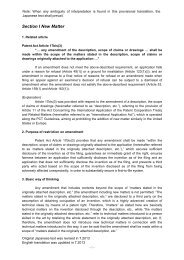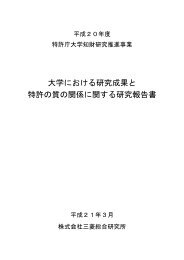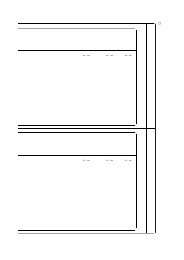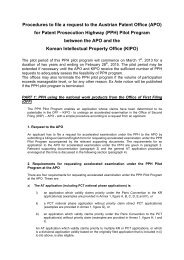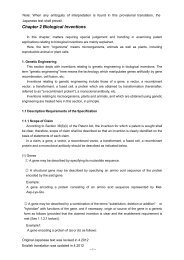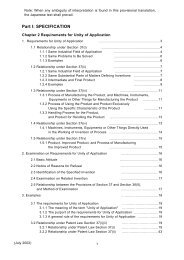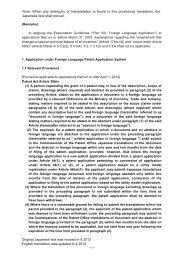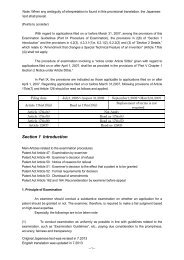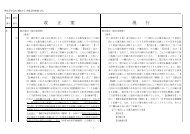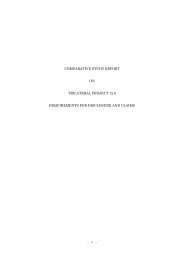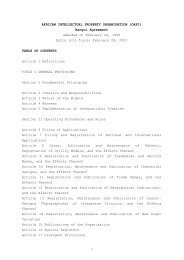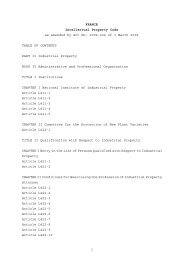Chapter 2 Novelty and Inventive Step - Japan Patent Office
Chapter 2 Novelty and Inventive Step - Japan Patent Office
Chapter 2 Novelty and Inventive Step - Japan Patent Office
Create successful ePaper yourself
Turn your PDF publications into a flip-book with our unique Google optimized e-Paper software.
Part II <strong>Chapter</strong> 2 <strong>Novelty</strong> <strong>and</strong> <strong>Inventive</strong> <strong>Step</strong><br />
are common, used among a person skilled in the art commonly, or understood by a person<br />
skilled in the art that they are not commonly used but related to the arts commonly used; or<br />
ii) Inventions included in either of the inventions whose working, functions, or characteristics<br />
are common, used among a person skilled in the art commonly, or understood by a person<br />
skilled in the art that they are not commonly used but related to the arts commonly used, but<br />
some of the working, functions, or characteristics are combined <strong>and</strong> the combinations are<br />
included in the inventions defined by said i) as a whole.<br />
The following are examples of this case in which the examiners have a reasonable doubt<br />
that the products in the claimed invention <strong>and</strong> cited inventions are prima facie identical in respect<br />
to the claims providing numerical ranges or numerical formulae, including inequalities, which<br />
define the products by "working, functions, or characteristics":<br />
I. The "working, functions, or characteristics" of the claimed inventions are found to be<br />
convertible to other working, functions, or characteristics specified by other definitions or<br />
testing or measuring processes, <strong>and</strong> it is found that the products of the cited inventions are<br />
considered to be identical to those of the claimed inventions from the results of the<br />
conversion;<br />
II. The claimed inventions <strong>and</strong> cited inventions, which are defined by identical "working,<br />
functions, or characteristics," have different measurement conditions on the "working,<br />
functions, or characteristics" that have a constant relationship with measurement values,<br />
where the "working, functions or characteristics" of the cited inventions are highly likely to be<br />
included in the values in the numerical ranges or numerical formulae, including inequalities,<br />
in the claimed inventions when the "working, functions, or characteristics" of the cited<br />
documents are measured by the conditions of measurement of the claimed inventions;<br />
III. The claimed inventions <strong>and</strong> cited inventions, which are defined by similar "working,<br />
functions, or characteristics," have different evaluation processes <strong>and</strong> also have a constant<br />
relationship between the evaluation processes, where the "working, functions, or<br />
characteristics" of the cited inventions are highly likely to be included in values of the<br />
numerical ranges or numerical formulae, including inequalities, provided in the claimed<br />
inventions when the products of the cited documents are defined by the evaluation processes<br />
of the claimed inventions;<br />
IV. The cited inventions are found to be identical or similar to the arts described in the<br />
working examples in the specifications or drawings of the claimed inventions, such as cited<br />
inventions providing identical manufacturing processes <strong>and</strong> similar starting material to those<br />
described in the working examples, or cited inventions providing similar manufacturing<br />
processes <strong>and</strong> identical starting material to those described in the working examples; <strong>and</strong><br />
V. The cited inventions <strong>and</strong> claimed inventions have common matters used to specify the<br />
inventions other than sections by the "working, functions, or characteristics" <strong>and</strong> the cited<br />
inventions provide problems to be solved or effects of the inventions identical to the problems<br />
or advantageous effects in the matters used to specify the inventions by the "working,<br />
functions, or characteristics."<br />
3.2 Notice of Reasons for Refusal Based on Reasonable Doubts that the Claimed Invention<br />
<strong>and</strong> Cited Invention Are Prima Facie Identical<br />
29



